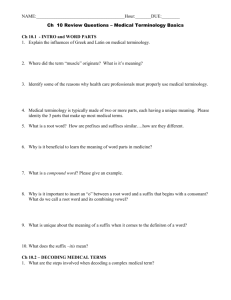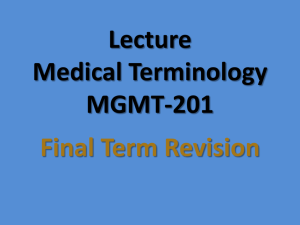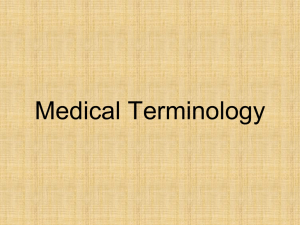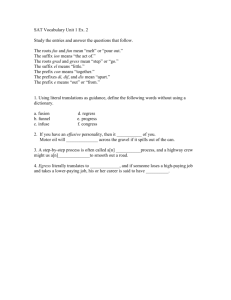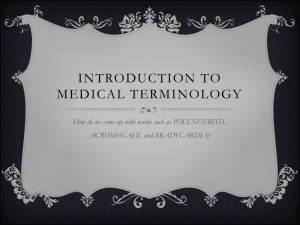Medical Terminology
advertisement
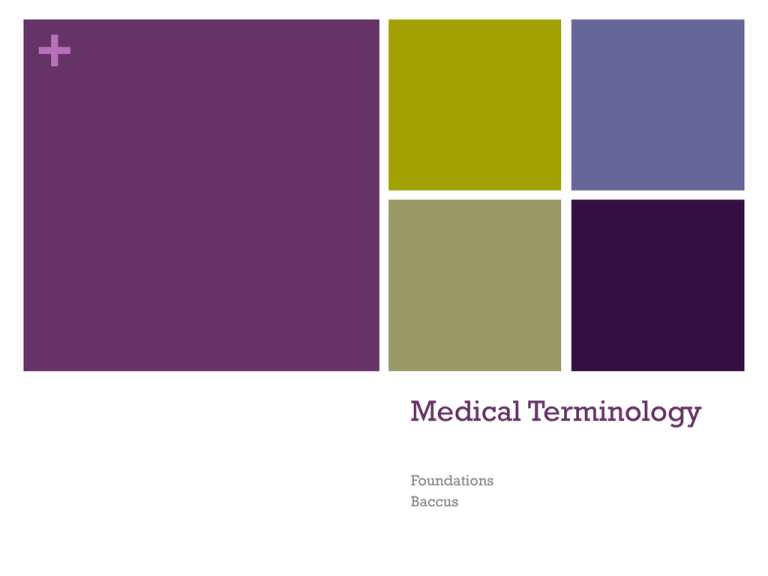
+ Medical Terminology Foundations Baccus + Using Word Parts to Build Medical Terminology Word root (WR) – The basic meaning of the medical term, usually from Latin or Greek words. Examples: neur = nerve cost = rib + Using Word Parts to Build Medical Terminology (cont.) Combining form (CF) – Word root plus a vowel, usually an “o”, to help in pronunciation. Examples: neur/o = nerve cost/o = rib + Using Word Parts to Build Medical Terminology (cont.) Suffix (S) – Attached to the end of a word, to change the meaning to a noun, adjective, or verb. All medical terms have suffixes. Examples: -ectomy = excision or surgical removal (N) -al = pertaining to (A) + Using Word Parts to Build Medical Terminology (cont.) Prefix (P) – Attached to the beginning of a word, to describe, modify, or limit. Not all medical terms have prefixes. Examples: trans – across, through intra – in, within sub – less than, under + Decoding Medical Terms Start with the suffix (the word ending), and define the suffix. Go to the prefix; define the prefix. Then, go to the middle of the word; define the word root, combining form, or both if both exist in the same word. Combine the definitions. + Section 5-1 Apply Your Knowledge When defining a medical term, you should start with which part? Answer: When defining a medical term, you should start with the suffix. + Compound Words Prefix Word Root Suffix + Compound Words (cont.) Combining Forms: Transneurocostal Suffix - al = pertaining to Prefix trans = across Combining form neur/o = nerve Word root cost = rib Definition: Pertaining to across the nerves of the ribs. + Plural Forms When a singular word ends in y, the plural is often formed by changing y to i and adding es. When a singular word ends in a, add e to form the plural. If a singular word ends in um, change the um to a to form the plural. + Section 5-3 Apply Your Knowledge What is the plural form of each of the following? emergency emergencies fimbria fimbriae atrium atria + Section 5-4 Apply Your Knowledge #1 Identify the condition or procedure identified by each of the following terms: – Hematology Study of the blood. – Tracheotomy Cutting into the trachea. – Rhinitis Inflammation of the nose. – Gastritis Inflammation of the stomach. – Pharyngitis Inflammation of the pharynx. Osteoarthritis Inflammation of the bones and joints. – + Apply Your Knowledge #2 Identify the condition or procedure identified by each of the following terms: – Nephrology Study of the kidney. – Pancreatitis Inflammation of the pancreas. – Mastectomy Removal of the breast. – Opthalmoscopy Visual examination of eye. – Amenorrhea Without menstruation. – Dermatitis Inflammation of the skin. + Medical Abbreviations System Abbreviations: “When in doubt spell it out.” Abbreviations can consist of the first letter in each word in the term. Example: CXR = chest X ray Example: ER = emergency room Abbreviations can be from Latin or Greek. Example: Abbreviation for Latin phrase ante cibum is a.c. = before meals + Section 5-5 Apply Your Knowledge What do the following orders mean? Vital signs every 4 hours. – VS q4h Nothing by mouth. – NPO – BUN, FBS, and Blood MRIurea in am nitrogen, fasting blood sugar, and magnetic resonance imaging in the morning. + Abbreviations Shortened forms of words Can be used alone or combined BR c BRP, FFl qh, VS qid NPO 8 pm, To Lab for CBC, BUN, and FBS + Word Creation Using words of your medical terminology tests, create words and define them. Make sure they are real words. Create puzzle of words you create. + Week #1
